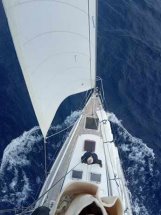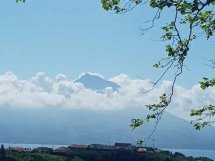34 Horta and Homeward,

|
Friday 16th. We
currently have 600 miles to go to Scilly and are about half way. The
passage has been reasonably straight-forward and our position at 1300hr was
45:31.00N 019:37.40W. The time spent
in and around Horta was a great experience: the weather, apart from being a bit
windy at anchor for 24 hours, was fine. The island of Faial, Horta is the
main town and port, was very green, highly agriculturalised and with a
low-density of dwellings had an alpine look. Clearly of volcanic origin situated
on the Mid Atlantic Ridge, small volcanic mounds are evident close to Horta and
some of the coastal bays are volcanic caldera but the ‘big daddy’, the extinct
volcano of Pico on the island of Pico, and Portugal’s highest mountain, is
visible just across the water from Horta – when the cloud allows - but often the
peak is above the cloud level.
Looming over Faial itself, and often in cloud, is the caldera of a long-
extinct volcano with an elevation of 1000 m. Keith and I took a hire car up to the
caldera on a beautifully clear day and gawped at the scale: there is a 7km walk
right around the perimeter, the caldera is about 3km across and, guessing here,
about 500 m deep. The interior, as
far as I could see, is inaccessible to ramblers, and is a sheltered,
micro-climate containing examples of most of the island flora and fauna-
according to the notice board. Depending on rainfall there are sometimes lakes
in the lowest part of the crater.
When we walked a bit of the perimeter, the sun was out, there were no
clouds and the only sounds were bird song and from insects. The foliage had a lovely ‘high moors’
aroma that reminded me of Exmoor walks. Having the car
for a day we also drove out to the far west of the island to visit an abandoned
light house that had been partly buried by lava and ash from an eruption just
off the coast in 1957 that formed an extension to the island. The dwellings associated with the light
house comprised a two- story building and ash had buried the building so that
only the very top of the ground floor window frames were visible. To enter the lighthouse,
therefore, required descending the equivalent of normal house flight of stairs
to reach the base of the tower from the new ground level. From the parapet of the lighthouse the
view of the surrounding area was of a barren, black, ash and gravel moon scape,
with only the hardiest of scrub bushes trying to establish a
hold. Getting the
furling system replaced or repaired turned out to be a damp squib. MAYS (Mid Atlantic Yacht Services) who
had said they had a replacement furling system, wouldn’t look at the boat until
we had an along-side berth. I badgered the harbour master as soon as the weather
improved and he put me alongside a wall on Wednesday evening, On Thursday, I had
an apologetic What’s App from Duncan Sweet at MAYS simply saying that it turns
out they didn’t have a furling system in stock after all! Duncan then went off for lunch and I
never managed to contact him again.
One of his staff picked up my email saying how disappointed I was; they
said that to order new bearings in from Profurl in France was likely to be a two
to four week delivery but suggested they had, in the past, repaired furlers
using non-standard bearings. I
asked if their rigger could attend
to discuss the feasibility of a repair; he called around on Thursday morning but
the outcome was not positive: the
old housing would have to be machined to take an off-the-shelf bearing, the
timing for this was not clear, we would have to remove the housing to do the
work, this might preclude using the foil if we couldn’t reassemble due to
corrosion or breakage. Hearing that I wanted to replace the old unit rather than
repair it, Jaol, the rigger, was of the impression we should sail back to the UK
for a replacement and not spend time and money on a repair. We had already sailed 1600 miles
changing sails in the foil (rather than furling/unfurling) so, in the end, the
co-pilots agreed that was least worst option, and returned to anchor in the
harbour. On the way to anchor we rafted up outside the marina office and filled
up with diesel and water. Friday was the
day we had a hire car and on returning to Horta we collected the Genoa which had
gone in for minor repair and reinforcements and then used the car to for a major
supermarket shop to stock to up for the 1200-mile trip back to the UK. On Saturday
Keith and I took the ferry across to Pico for a wander around Madalena, the main
harbour. The volcano itself was
shrouded in cloud so not inviting to climb, even if we had felt strong
enough. We had some lunch in the
town square and then visited a museum dedicated to the Pico winery. Vines on Pico were grown in cracks
in the gravelly lava in earth transported from Faial, individual vines were
surrounded by walls made of lava stones; these provided shelter from the wind
and the stones held the sun’s warmth.
Looking over the vineyard it appeared to resemble a giant, black,
honeycomb with a central brilliant green splash of colour in each cell. The only downside was that there were no
samples! A bar, or even an
ice cream shop, would have made a killing. Brian joined a dive trip while we
were away. Sunday was
departure day: the wind which had been northerly for a good while obligingly
turned southerly, as forecast. Last
showers were taken ashore, shopping for perishables was undertaken, a last lunch
in Peter’s Bar was enjoyed and then it was back to the yacht to deflate and stow
the dinghy and lay out the Genoa on deck. We removed and stowed the anchor
and hoisted the main sail in the harbour and then motored out of Horta in the
late afternoon heading north.
During the first night we could see lights and lighthouses on Faial, Sao
George, and La Graciosa but thereafter it was the open sea and surprisingly
devoid of other vessels. We headed
north for two days as recommended by the sailing directions (World Cruising
Routes, Jimmy Cornell) took the mainsail down on the second night in 30 knots
and torrential rain and ran under storm jib. Thereafter we have had a steady 16 to 20
knots on the quarter allowing us to sail directly towards the Isles of Scilly
and enough wind for the working jib to set. We have been averaging 130 miles a day
since altering course for scilly. I
went up the mast in the bosun’s chair on one of the lighter days, only as far as
the first spreaders, to put some reinforcement patches on some weak points on
the luff of the mainsail. We also had
thunder and lightning overhead one morning at the 0700 change of watch. This was accompanied by very heavy rain
and an increase in wind necessitating a reef in the main – but should you stand
by the only lightning conductor for miles around to lower the sail, with
simultaneous flashes and thunder overhead?
We reefed. If we got struck it would probably be all over, if we didn’t
reef we might trash the mainsail and progress then would be very slow; Brian did
put on his rubber soled shoes -just in case. I also put all the computers, phones,
hand-held radios and the GPS set in the oven to protect them from a strike. If the yacht survived a strike, that is,
not blown to pieces, we would probably lose all the installed electrics, so the
small computers and phones are our fallback navigation. The oven is supposed to be a Farraday
cage and, as we all remember from school physics, it is impossible to charge the
inside of a metal box. Since altering
course for Scilly we have been sitting almost continuously in the southerly and
south westerly airflow associated with a weak depression to the north of us (It
is great being on the right side of the low for a change). The depression seemed to be almost
stalled, perhaps balked by the high pressure over northwest Europe which is
giving the UK a fine summer and easterly winds. But now the low is starting to move
northeast and we expect the wind to swing from south westerly through south to a
north westerly direction in the next 24 hours, probably with more rain if there
is an associated front. However, it
still looks good for continuing progress. We are eating
well; breakfast tends to be a help-yourself to cereal depending on watch
changes, we usually do something light for lunch: salad and cheese while we have
fresh food, then perhaps wraps with some filling made from coleslaw, grains and
beansprouts, or simply bread and cheese. Thanks to Cilla’s advice, we have
been sprouting Mung beans very successfully and these make a crunchy salad
alternative when the lettuce and cucumber have gone. We take it in turns to make an evening
meal for about 6:30/6:45 pm coinciding with a watch change and eat
together. These are usually
one-pot meals based on pasta, rice or potatoes, sometimes eggs. We have been using soya protein instead
of meat as it is easier to keep. I
also bought some chorizo sausages which work well in stews and the
like. The boat has
been accompanied by the most amazing soaring birds since Faial. They are dusty brown on top, light
underneath and their wings curve downwards. They fly with barely a flap of the wings
and soar over waves, apparently effortlessly, with wing tips not quite grazing
the water but sometimes leaving a slight trail in the water from the turbulence
shed from the wing tips. We
have reference sheets for identifying whales and porpoises, but nothing for
seabirds. I’d love to know what
they are; I’m guessing Fulmar but it’s only a guess. The next
update will be from UK waters. All best, Tony, Keith and Brian
|





